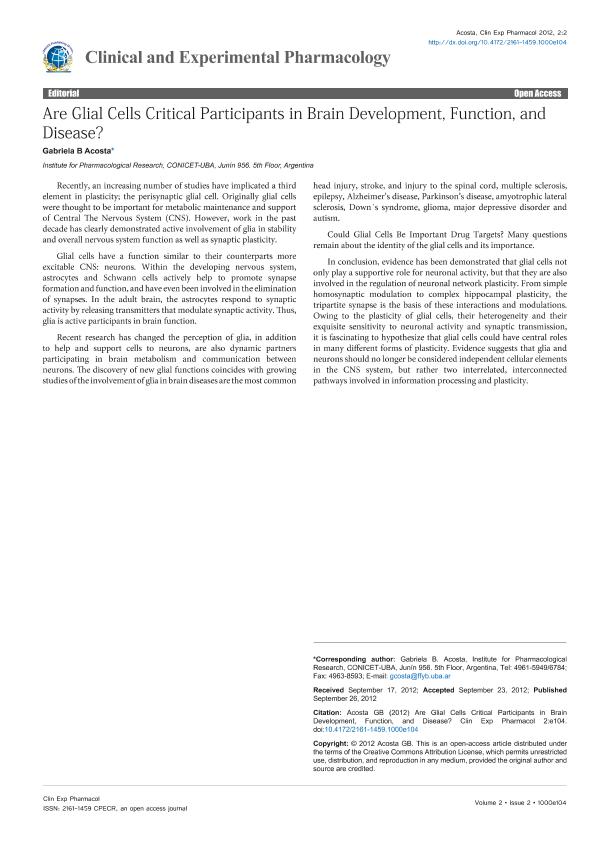Artículo
Are Glial Cells Critical Participants in Brain Development, Function, and Disease?
Fecha de publicación:
09/2012
Editorial:
OMINCS
Revista:
Clinical and Experimental Pharmacology
ISSN:
2161-1459
Idioma:
Inglés
Tipo de recurso:
Artículo publicado
Clasificación temática:
Resumen
Recently, an increasing number of studies have implicated a third element in plasticity; the perisynaptic glial cell. Originally glial cells were thought to be important for metabolic maintenance and support of Central The Nervous System (CNS). However, work in the past decade has clearly demonstrated active involvement of glia in stability and overall nervous system function as well as synaptic plasticity. Glial cells have a function similar to their counterparts more excitable CNS: neurons. Within the developing nervous system, astrocytes and Schwann cells actively help to promote synapse formation and function, and have even been involved in the elimination of synapses. In the adult brain, the astrocytes respond to synaptic activity by releasing transmitters that modulate synaptic activity. Thus, glia is active participants in brain function. Recent research has changed the perception of glia, in addition to help and support cells to neurons, are also dynamic partners participating in brain metabolism and communication between neurons. The discovery of new glial functions coincides with growing studies of the involvement of glia in brain diseases are the most common head injury, stroke, and injury to the spinal cord, multiple sclerosis, epilepsy, Alzheimer’s disease, Parkinson’s disease, amyotrophic lateral sclerosis, Down´s syndrome, glioma, major depressive disorder and autism. Could Glial Cells Be Important Drug Targets? Many questions remain about the identity of the glial cells and its importance. In conclusion, evidence has been demonstrated that glial cells not only play a supportive role for neuronal activity, but that they are also involved in the regulation of neuronal network plasticity. From simple homosynaptic modulation to complex hippocampal plasticity, the tripartite synapse is the basis of these interactions and modulations. Owing to the plasticity of glial cells, their heterogeneity and their exquisite sensitivity to neuronal activity and synaptic transmission, it is fascinating to hypothesize that glial cells could have central roles in many different forms of plasticity. Evidence suggests that glia and neurons should no longer be considered independent cellular elements in the CNS system, but rather two interrelated, interconnected pathways involved in information processing and plasticity.
Palabras clave:
Glia
,
Neuron
,
Central Nervous System
,
Synaptic Activity
Archivos asociados
Licencia
Identificadores
Colecciones
Articulos(ININFA)
Articulos de INST.DE INVEST.FARMACOLOGICAS (I)
Articulos de INST.DE INVEST.FARMACOLOGICAS (I)
Citación
Acosta, Gabriela Beatriz; Are Glial Cells Critical Participants in Brain Development, Function, and Disease?; OMINCS; Clinical and Experimental Pharmacology; 2; 2; 9-2012; 2-3
Compartir
Altmétricas




